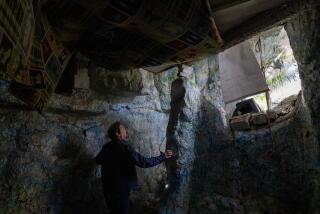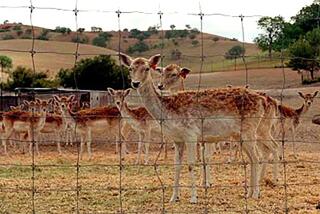Editorial: Los Angeles needs open space for wildlife and for our sanity
For years, residential developments in the hillsides and canyons of Los Angeles have encroached on wildlife as our neighborhoods have spread into, well, theirs.
It’s not surprising that we keep expanding; the city has more people than it used to, and we need housing desperately. But we also need open space, not just for our sanity and for the beauty of our city, but also if we care about maintaining an urban wildlife population.
One way to preserve open space is to buy it. That’s what an alliance of community groups and wildlife advocates vowed to do to protect a 17-acre mountain ridge in the Hollywood Hills above the Laurel Canyon neighborhood. Two years after starting their fundraising campaign, Citizens for Los Angeles Wildlife, a nonprofit preservation group, and Laurel Canyon Assn., a neighborhood organization, announced in late December that that they had successfully raised the $1.6 million they needed to buy the mountain ridge. Donations came from individuals (including $100,000 from musician Don Henley), the Santa Monica Mountains Conservancy, foundations, L.A. City Council members Paul Koretz and David Ryu, who contributed from their discretionary funds, and County Supervisor Sheila Kuehl, who persuaded the Board of Supervisors to approve a $100,000 grant.
It’s challenging but it’s possible to leave space in the bustling metropolis for the wildlife that was here long before us.
It was an ambitious community effort that will save what is in effect an oasis for a passel of creatures otherwise stuck in an increasingly dense city. Anyone who doubts its importance to those animals need look no further than the nature cam on the site of the preserve that has photographed deer, coyotes, quail, a bobcat, a fox and one untagged mountain lion strolling about. The land has now been given to the Mountains Recreation & Conservation Authority, a local government entity, to manage and preserve. That makes the land public, open to everyone, although it’s difficult to access and has no hiking trails. Mostly, it is animals that will use this stretch of land and drink from its natural spring. For them, this is the definition of a hot property.
Still, there should be less dramatic and less costly ways to help animals survive. In fact, the city passed an ordinance nearly two years ago that would require developers in a designated wildlife habitat linkage zone to build pathways or leave space through their properties to serve as wildlife corridors. The problem is that the ordinance has yet to be implemented. The city should get moving.
In another recent development, the California Department of Fish and Wildlife is changing its policy in the Santa Ana and Santa Monica mountain areas for issuing “depredation permits” requested by residents whose pets or livestock have been killed by mountain lions. Until now, these permits have allowed people whose livestock or pet has been killed by a lion to kill the lion in return, despite laws that make it illegal to hunt them. Interactions between mountain lions and humans — or, more specifically, their domestic animals — have increased as people have moved closer to wildlife territory. The problem is, when mountain lions kill easy prey they are only doing what comes naturally to them. Revenge killing is not a sound policy for dealing with these interactions.
Now, instead of immediately issuing a permit to kill a lion after it has killed an animal, the department will, essentially, give the lion three strikes before issuing a depredation permit that could lead to its death. On a first report of a mountain lion killing a pet or livestock animal, the resident will be taught about measures to take for future protection (such as securing animals in enclosures at night so they don’t become easy prey). They will also be allowed a permit to haze or shoo the lion away with, say, motion-sensitive lights or loud music. If the lion comes back and kills again, the resident can get a permit to escalate measures — shooting bean bags at the lion, for example. If the lion kills a third time, a permit can be issued to kill the lion. This is a rational approach because it protects these majestic creatures unless it becomes clear they cannot be discouraged from stalking specific locations.
Los Angeles County is an extraordinary mix of urban and wild, humans and wildlife. It’s challenging, but it’s possible to leave space in the bustling metropolis for the wildlife that was here long before us.
Follow the Opinion section on Twitter @latimesopinion or Facebook
More to Read
A cure for the common opinion
Get thought-provoking perspectives with our weekly newsletter.
You may occasionally receive promotional content from the Los Angeles Times.






